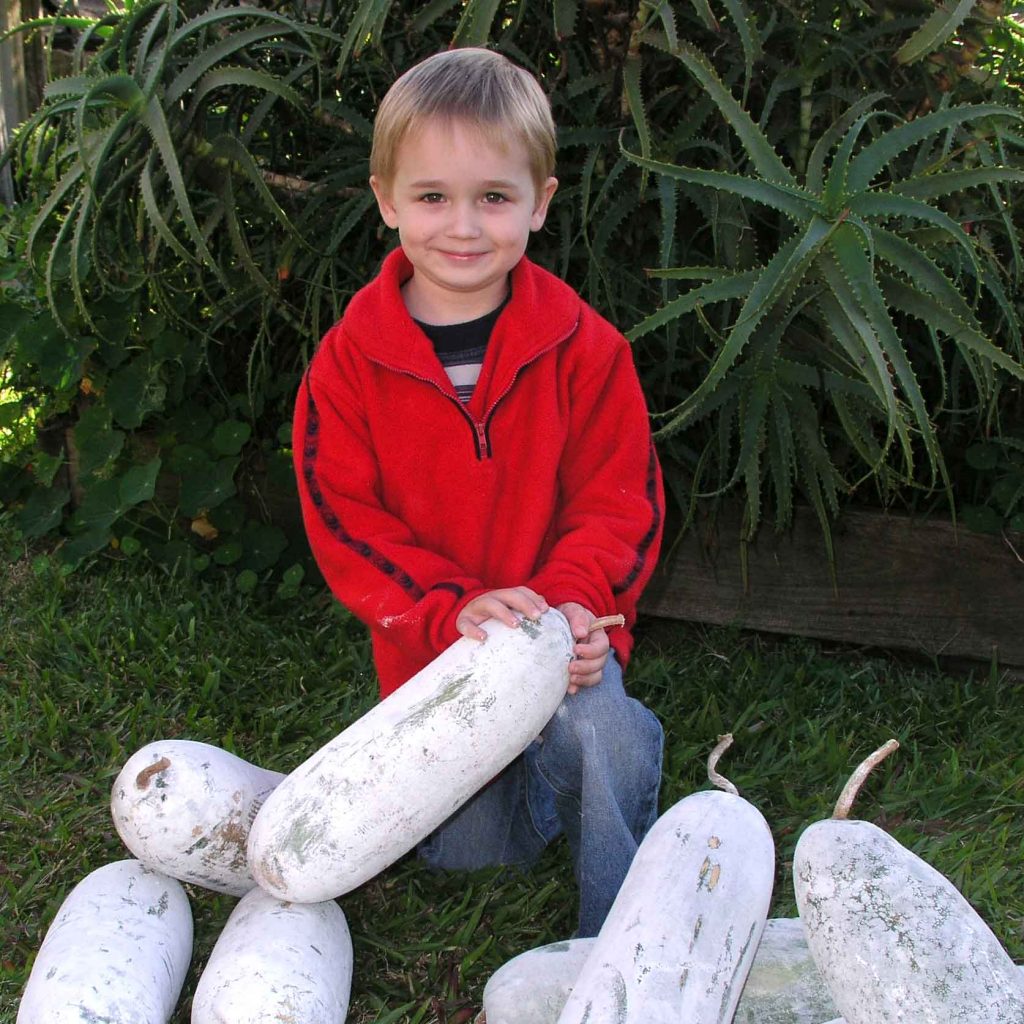As mentioned under ‘Self-sufficiency’ chapter (p 8), survival plants that are hardy have a long cropping period or a long shelf life.
These, can be prepared in various ways, or even dried for later use … and are rare or somewhat obscure … and, therefore, valuable for your edible garden. In this section I will highlight a few practical plants to grow, however, this is not a complete compendium, as it is not possible within the scope of this book to include all such potential plants.
… … omitted text, please see How can I be prepared with Self-Sufficiency and Survival Foods? for full text.

Flour gourds Benincasa hispida (cover picture no. 5) for 12 months or more. (No doubt, this is because the coating of white flour-like substance provides a protective shield on the skin of the gourds.) The white flesh of the gourd has little flavour. However, as a bulking food it is ideal to add to stews, soups, stir-fries, roasts, casseroles, pickles and jams. Small seeds may be eaten, too. In traditional Indian Ayurvedic medicine, the seeds are eaten for difficult urination and bladder stones, and taken for expelling intestinal tapeworms. The seeds are said to enhance the intellect, and these are eaten for mental imbalances (eg nervousness, frustrations, and anger). The flesh of the vegetable is considered a rejuvenating food, capable of improving intellect and physical strength, benefiting the digestion, lungs,heart, nervous system, and pancreas; and, also, as an antidote for poisoning from food, mercury and alcohol. When the garden produces lots of flour gourds feed some to your hens; cut the gourd in half, length-wise, and these will be eagerly devoured by laying hens.
… … omitted text, please see How can I be prepared with Self-Sufficiency and Survival Foods? for full text.
Arrowroot Canna edulis, p 44, is a versatile survival food; a hardy deciduous perennial, 2 metres high, with thick stems and large leaves. This fast-growing plant is useful for a quick windbreak or to create a microclimate. Foliage can be used for garden mulch and as poultry and stock fodder (protein 10%). The large rhizomes/ tubers can grow bigger than a clasped fist and develop many side shoots to form a large clump. Tubers are easily dug and are best used when young, as older tubers tend to develop a fibrous texture. Arrowroot can be eaten raw, steamed, roasted or diced and added to casseroles, stir-fries, soups, stews, and made into chips. The root, when pulverised, rinsed, drained, and dried, provides real arrowroot flour, ready to use as a thickener in sauces, gravies and fillings.
West Indian arrowroot Maranta arundinacea, p 44, grows to 1 metre, yielding smaller tubers that are eaten raw, cooked, grated into a course meal, or made into flour. Young leaves of both these species are eaten raw or cooked.
… … omitted text, please see How can I be prepared with Self-Sufficiency and Survival Foods? for full text.
Sweet fruit root Polymnia sonchifolia, p 30, due to its sweet taste and crunchy texture has been called ‘apple of the earth’. The large tubers that grow underground may weigh from 200g to 2 kg, and are eaten raw and cooked. It is a hardy bush 1-2 metres tall, and deciduous in winter (except in very warm climates). Tubers can be fossicked over many months of the year, which makes it a valuable survival food plant. Slices can be dried, to add to your supply of stored foods. Dig, wash, and eat tubers, fresh in hand, after lightly peeling. Dice root and add to fruit salads or stir-fries, curries, sweet and sour dishes, pickles, or juice for a refreshing drink. Tubers are over 9% protein, very high in potassium (2230mg per 100g), calcium (143mg per 100g), iron (55mg per 100g), and are a good source of inulin. The inulin content of this wonderful food has proved beneficial in stabilising blood sugar levels. Being low in calories, this is a practical food for dieters and diabetics. Fructose, in the roots, enhances the digestion of foods, particularly the metabolism of carbohydrates, and has a thermogenic effect, helping the body burn off kilojoules that have been stored as fat.
Taro Colocasia esculenta, p 53, and many other Colocasia species are hardy food plants, for warm to tropical climates. Large leaves that look like elephants’ ears stand on thick stems 1 metre tall. Tubers develop at the base, and some may grow to over 10kg in weight. The tubers, stems and young leaves are eaten as a cooked vegetable, steamed, roasted, fermented, added to stir-fries, soups, meat and savoury dishes, and prepared with coconut cream. Before cooking the tubers, peel thickly, and soak the diced tubers in cold water for an hour, then drain water, put on fresh water and cook approximately 15-20 minutes until soft. Caution: never eat any part of the taro raw. Since oxalates occur in the leaves, stems and tubers, cooking is required to neutralise these crystals.
A delicious desert: Taro Fantastic is made, by blending cooked taro with eggs, coconut milk, vanilla and palm sugar. Use your personal preference for sweetness to estimate quantities, as the texture should be a thick pouring consistency. Bake in a moderate oven, until set.
Eve’s Taro Dip: Mash or blend steamed taro with enough coconut milk or cream to be of a dip consistency; add a dash of chilli sauce … and hey-presto! Enjoy this simple, yet wonderful dip. Eve also serves steamed and cubed taro with a dash of salad dressing as scrumptious nibbles.
Coco Yam Xanthosoma sagittifolium, p 73, is related to taro, and very similar in appearance, growing requirements, and preparations for eating. Roots, must be cooked to eat, and have a sweet, nutty flavour. Leaves must be cooked well.
… … omitted text, please see How can I be prepared with Self-Sufficiency and Survival Foods? for full text.
Carob Ceratonia siliqua, p 28, a legume evergreen tree, suitable for acreage land, provides a valuable survival food. Trees adapt to a wide range of climates and soils, including salinity. Hardiness and longevity are two features of the carob. The dark brown carob pods, to 15cm long, are a high-energy food, and an excellent source of protein and calcium. Mature pods, when thoroughly dry, will store for many years. Taste is similar to dates but with a harder texture, and need to be chewed well. When pods are slow roasted, they have a similar flavour to chocolate. During times of war in Europe and when food was scarce, many people were sustained by eating carob pods and a few wild foods. Carob has also been used during wartime to feed cavalry horses, as animals do very well on just a few pods a day. Pods provide excellent fodder for grazing animals, and can be collected and stored for times when fodder is scarce. Trees are ideal for providing shade, screening, noise barriers and windbreaks.
Preservation and storage of foods
The human body requires over 40 essential nutrients to function perfectly. We need to eat a variety of foods to provide these fundamentals that are vital to wellbeing. As the majority of the essential nutrients are not stored in the body, good health does depend on taking these nutrients in our foods, daily. We need to plan and execute a well-balanced diet under usual conditions, however, it could be more difficult if emergencies occur and foods are limited.
Under normal conditions, kitchen appliances, including the refrigerator and freezer, provide the solution to both short and long-term storage. Our reliance on these appliances and the convenience they represent can be realistically visualised by thinking and what might happen during a blackout of 48 hours or power failure for a week and or months. With a disruption of electricity to shops and homes, within a few days foods would spoil and many people would be relying on canned foods. Serious emergencies could bring a breakdown in transportation of foods. Groceries and fresh produce may become very scarce. Prices of food will then skyrocket and the suffering would be beyond our perception. Only those people sufficiently provident to prepare for such emergencies would be securely stocked.
Food stacked in a kitchen cupboard would provide a margin of safety for a few days and would carry most people through brief blackouts. A month’s supply of food, carefully stored away, would provide time for adjustment. In circumstances of major dilemmas,a year’s stored food would give enough time for readjustment or a complete transition.
In the bounty of our country of Australia, fresh food has been readily available at fairly reasonable prices. Our land has not experienced many calamities of climate, elements, or war on our shores, to cause food shortage. The problem of storage of food for an emergency is not a new one for people in so many areas of the world. In cold and temperate climates storing food for long winters has been essential to life. In all climatic zones, part of the harvest is stored and saved. However, the systematic storage of foods to provide essential nutrients for ‘the duration’ has only been set up by a minority of alert people. When speaking to these people, I often find that they have previously suffered extreme hardship from war or catastrophic weather conditions. Due to these experiences they have put in place sufficient storage for unforseen circumstances.
… … omitted text, please see How can I be prepared with Self-Sufficiency and Survival Foods? for full text.


